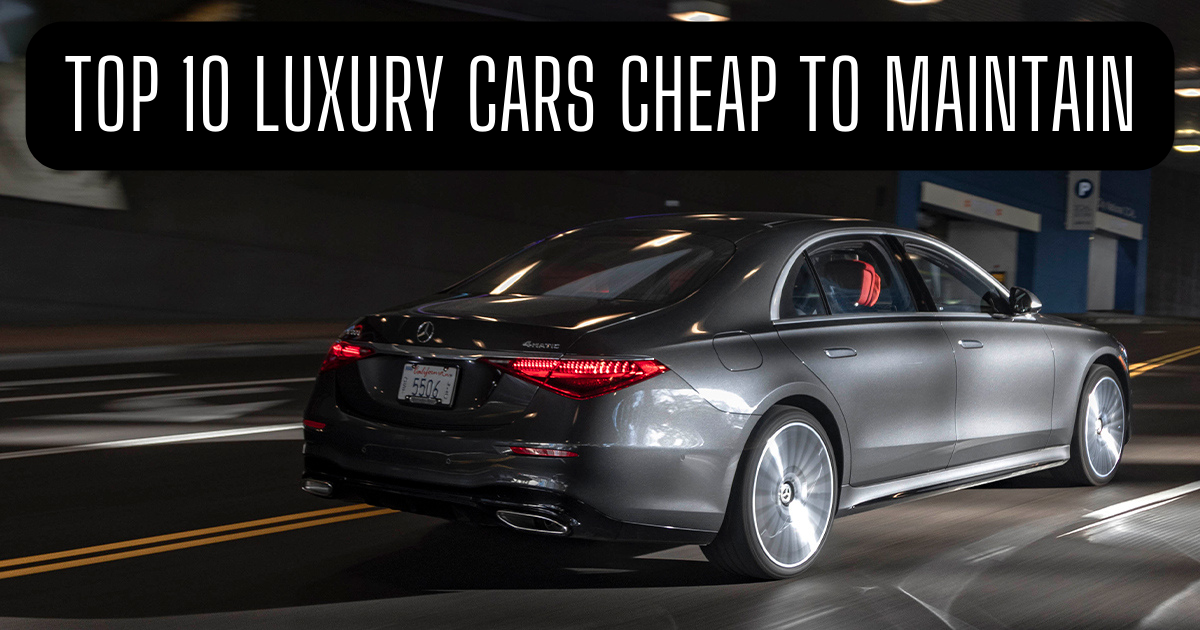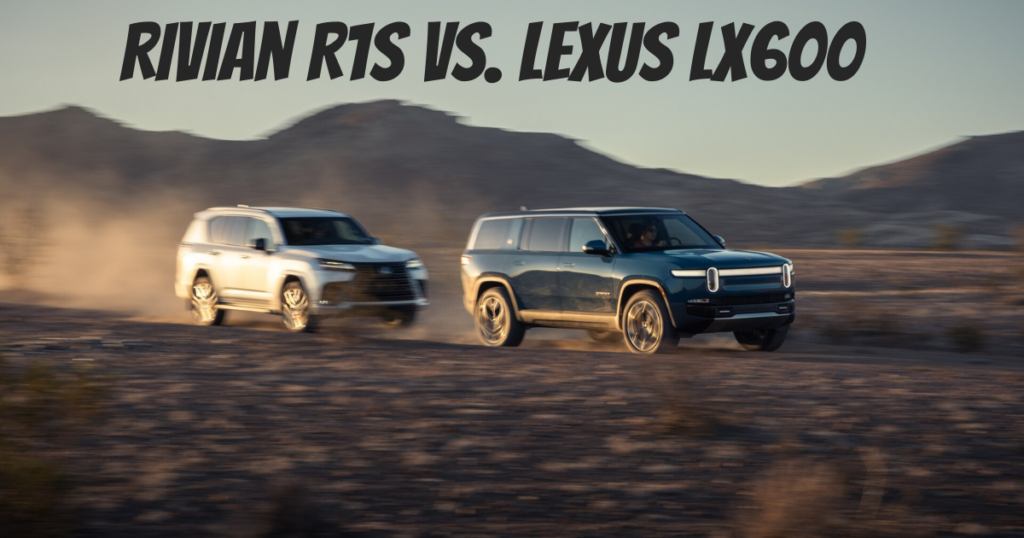
Americans are good at buying things they think they might need instead of things they really need. Last year, Americans bought hundreds of thousands of SUVs, the majority of which were like the Jeep Wrangler, Toyota Land Cruiser (RIP), and Land Rover Defender, which are both incredibly capable off-road yet likely to spend the most of their time on pavement. The Lexus LX600 and Rivian R1S are two new luxury SUVs that are destined to become part of that pretty gloomy club of disuse.
Surprisingly, these two luxury SUVs with an off-road focus are ideally adapted to compete against one another. When it comes to size, the Rivian and Lexus are almost exactly the same. Both have three rows of seats that can fit up to seven people and are just as good off-road. But they are driven by different engines. One is powered by electricity, and the other by gas.
Comparing Rivian R1S vs Lexus LX600
Let’s delve into a comprehensive comparison to understand the strengths and nuances of these formidable vehicles.
Specs Comparison
Lexus LX600
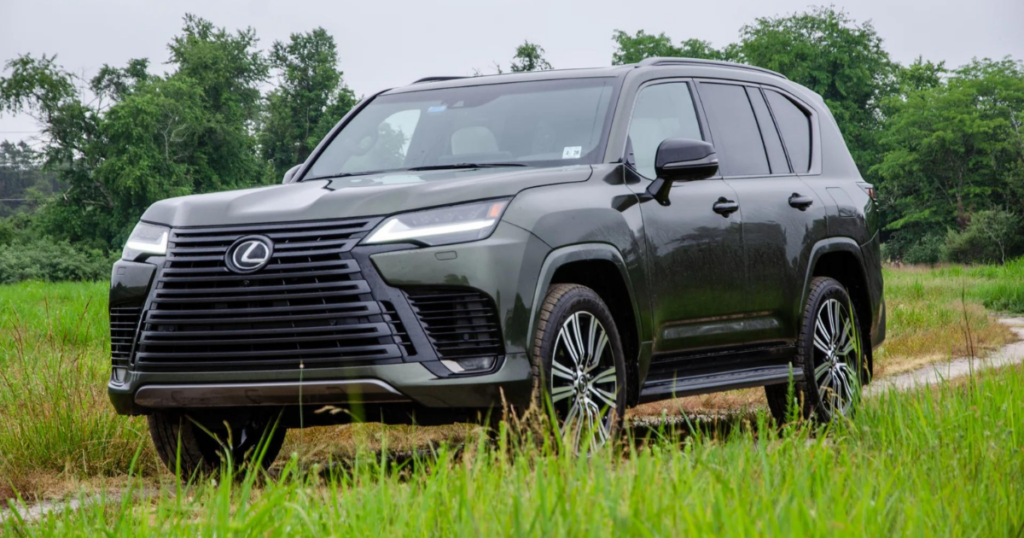
Both adventurers and mall crawlers inevitably perceive the Lexus LX600 Luxury as the more conventional of the two SUVs. The new LX600 has a new independent front suspension and an old-school live-rear axle. It also has Toyota’s new 3.4-liter twin-turbo V-6 engine, which is also found in the Sequoia, Tundra, and global Land Cruiser.
It makes 409 hp and 479 lb-ft of torque, which is 26 hp and 76 lb-ft more than the old 5.7-liter V-8 in the LX570. The power goes to a full-time four-wheel-drive transfer case through a new 10-speed automatic transmission (which replaces the old 8-speed). It has an EPA-estimated fuel economy of 17/22/19 mpg city/highway/combined, and its 21.1-gallon fuel tank allows it to travel close to 400 miles (643 km) on a single fill-up on premium.
Rivian R1S
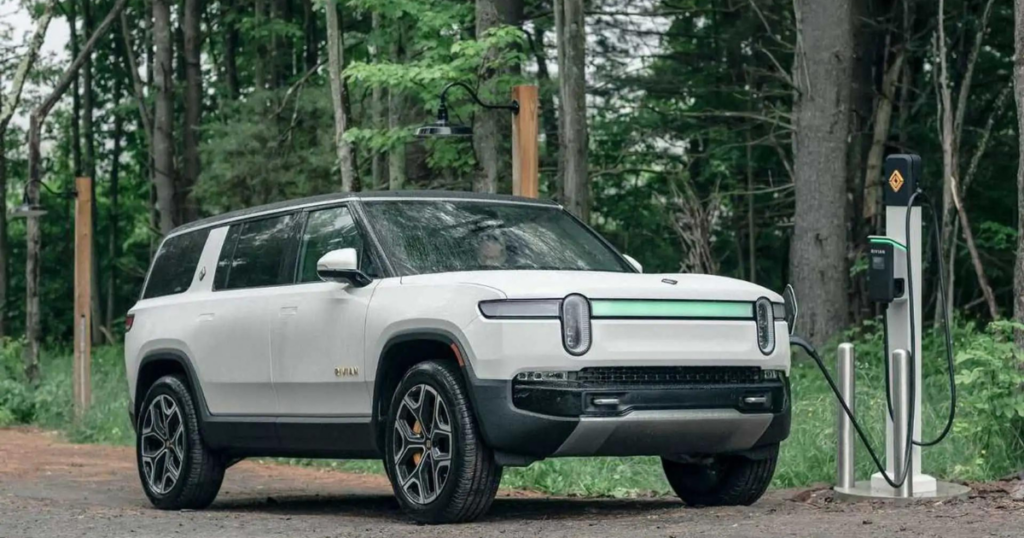
Under the hood of the Rivian R1S Launch Edition, there is nothing but storage space. Similar to the Trans-America Trail-crossing and Truck of the Year winning R1T, the electric R1S features a completely independent suspension and an innovative quad-motor arrangement, with one permanent-magnet motor driving each wheel separately.
Overall, the all-wheel-drive setup can produce an incredible 835 hp and 908 lb-ft of torque. The R1S’s quad-motor setup results in a 73/65/69 mpg-e rating, placing it among the least efficient (but also among the most competent) EVs available. The Rivian has a large 135-kWh fast-charging battery pack that can propel it 316 miles (508 km) on a single charge.
Verdict

Although the Lexus and Rivian have quite distinct powertrains, they approach off-road dominance in rather similar ways. R1S and most LX600 models feature adaptable air and hydraulic suspensions. This enables both manufacturers to adjust the damping rates for more sporty or pleasant rides while driving in real-time.
Additionally, it enables both vehicles to simulate an anti-roll bar disconnect and adjust ground clearance, ensuring that all four of their 22-inch (55 cm) all-season tires remain on the ground when off-roading (or simply traversing the Target parking lot). Both have software solutions to complement their hardware, with the Lexus offering Multi-Terrain Select (MTS) and Downhill Assist/Crawl Control (DACC) and the Toyota offering four on-road and five off-road drive modes.
Drive Comparison
Motortrend’s Performance Testing
According to Motortrend’s testing, the Rivian ran circles around the Lexus in Motortrend’s tests with the double power. It took only 3.1 seconds to accelerate from 0 to 60 mph (96 kph) and 11.6 seconds to complete a quarter mile at 111.2 mph (178 kph). In contrast, the LX took 6.1 seconds to reach 60 mph (96 kph) and 14.5 seconds to complete a quarter mile at 95.9 mph (152 kph). The R1S surpasses the Lexus In terms of handling and braking. It stopped from 60 to 0 mph in 121 ft (36 m), whereas the LX required 136 ft (41 m); it also completed a figure-of-eight pass in 26.1 seconds at 0.71 g average, whereas the Lexus took 28.4 seconds at 0.58 g average.
Lexus LX600
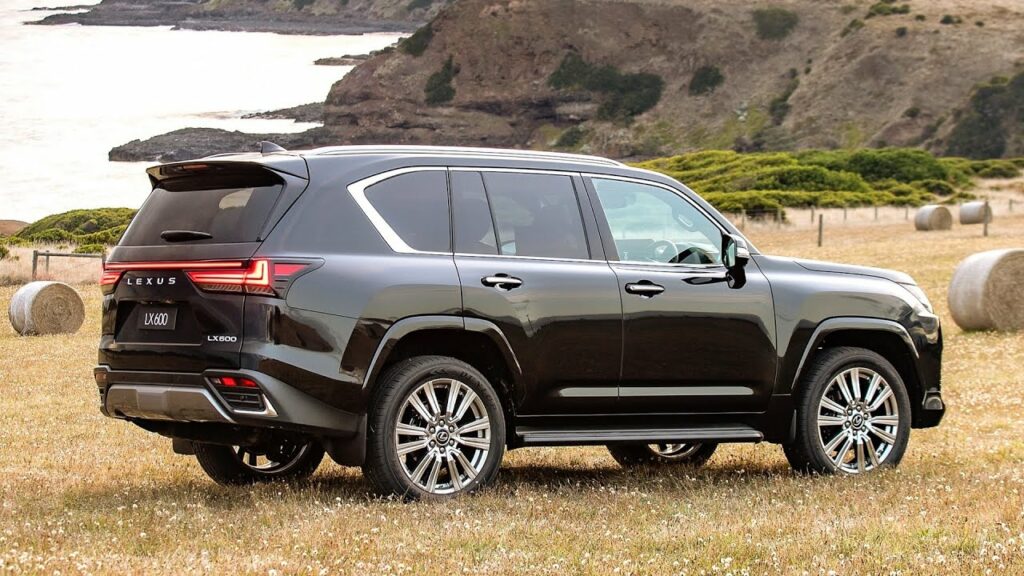
Although Lexus has a history of being quiet and refined, the LX600 falls short of this reputation. Turn on its V-6 and shift into drive and the entire car trembles like a horse pulling at its lead. Even at idle, the engine vibrates the back seats quite a little. After that, the experience doesn’t improve much.
The Lexus’s motor is sluggish and unresponsive at low speeds but improves once it gets going. Early upshifts and late downshifts tend to widen the performance difference with the R1S. Although the Lexus has a smooth ride, its suspension is not nearly as effective as the R1S’s at reducing body roll and mitigating secondary impacts, which results in severe body roll and brake dive when driving aggressively.
Rivian R1S

The R1S is remarkably calm and quiet in both urban and highway settings. The unusually long gas pedal travel makes it possible for the driver to apply the accelerator precisely, ensuring that the right amount of power is summoned in challenging driving situations. It also makes one-pedal driving smooth and simple, as the R1S is slowed without the need for brake pedal inputs by simply lifting off the accelerator.
At its softest setting, the R1S is a bit on the firm side, but it rides well, and even rough hits don’t bother it. In sport mode, the Rivian can be a lot of fun on a winding back road when the kids aren’t around. The four-motor setup of the R1S imitates the finest torque-vectoring mechanical all-wheel-drive systems, providing precise steering and a smooth ride as it threads through the traffic.
Verdict
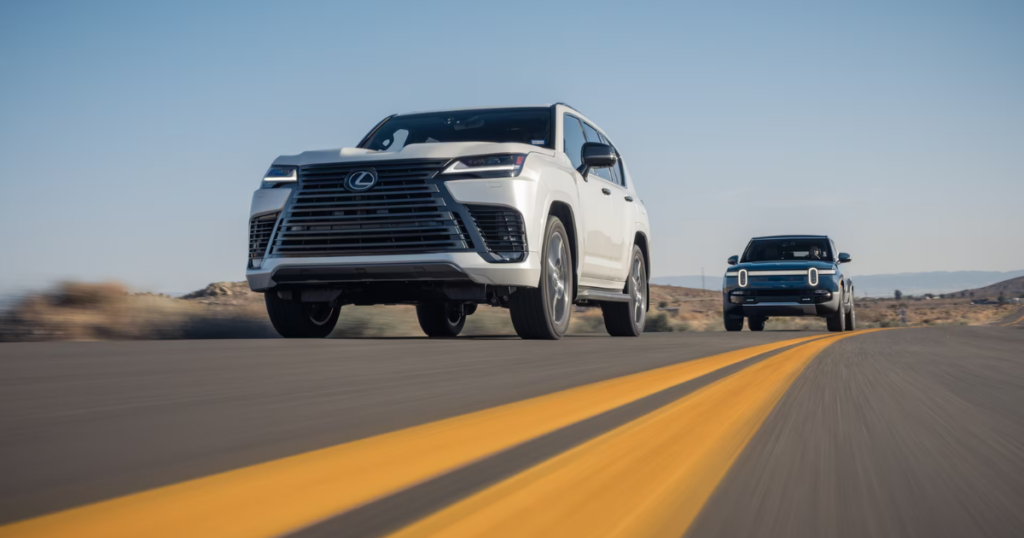
Although both vehicles are good to drive, the LX is great off-road. Despite some minor issues with the MTS and DACC knob’s usability and responsiveness, the Lexus did very well in its tests. As one might anticipate from its Land Cruiser heritage, it happily adapted to deep sand, moguls, and hill climbs when left on its own.
But the Rivian is as impressive. The R1S’s four motors are incredibly good at directing power quickly to the tire with the highest grip, which helps spin the vehicle around curves and guarantees forward motion regardless of the trail’s conditions. It’s more adaptable as well. The LX600 slogs down trails, but the Rivian can act like a Ram 1500 TRX and blast down them at high speeds if the going is good. Its exact wheel-by-wheel power metering allows it to go around obstacles at low speeds more adeptly than other factory off-road vehicles.
Interior Comparison
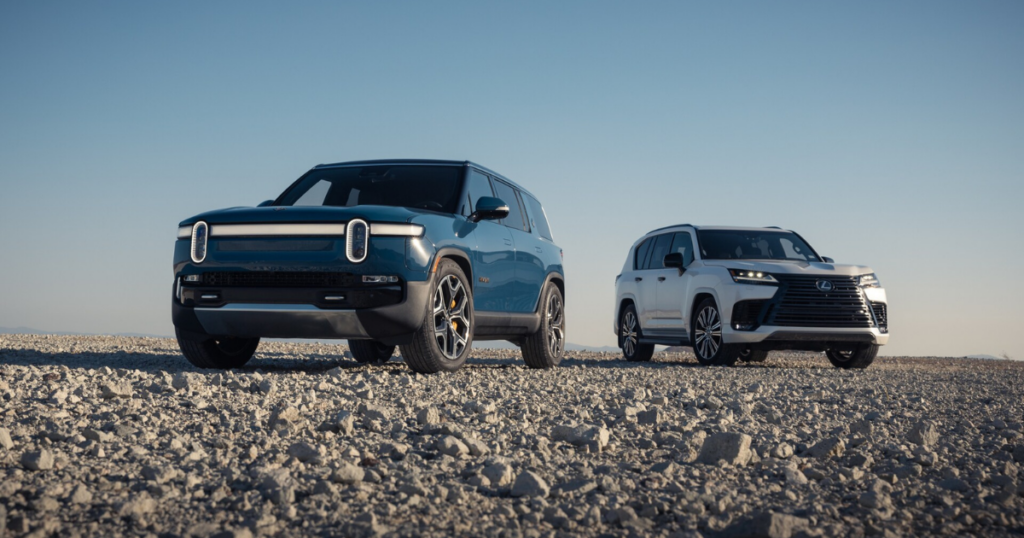
Lexus LX600
The LX600’s cabin is a hybrid of modern and classic luxury features, with a digital gauge cluster, an abundance of knobs and buttons, and a wood- and leather-trimmed center console. The lower touchscreen serves as a multi-function display for the climate control and off-road modes, while the upper touchscreen serves as the conventional infotainment system interface with Apple CarPlay and Android Auto compatibility and, most crucially, navigation if you “subscribe” to it.

The first two rows of the Lexus are comfortable and reasonably spacious, but the interior is not very well constructed, given the $100K price tag. Although third-row access is better than in the Rivian, passengers in the back may not pay attention to the Toyota-quality materials because of the narrow seat position and limited headroom. When the third row is folded, the Lexus’ cargo volume is just 11.0 cubic feet, although it is almost identical to that of the R1S (46.0 against 46.7 cubic feet). Notably, the second row of the Rivian folds flat, while that of the LX600 does not.
Rivian R1S
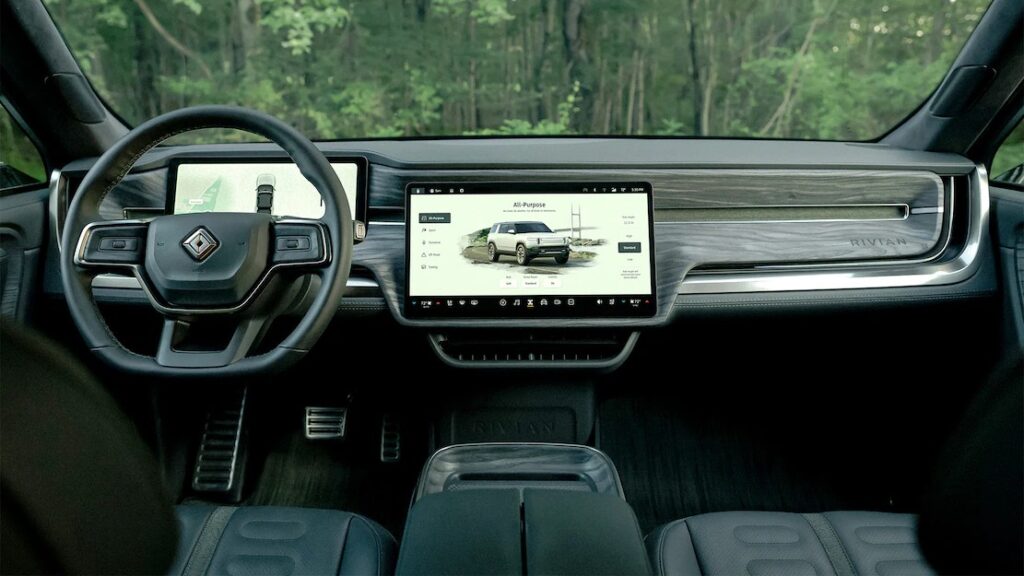
The Rivian maintains a lead over the Lexus in terms of cabins. Although some may find its big 15.6-inch (39.6 cm) landscape-oriented entertainment screen unsettling, the rest of the cabin is elegantly styled, including rich-feeling touchpoints, elegant wood trim, opulent faux leather seats, HVAC vents, and cupholders in every row. The first and second rows are roomy, cozy, and suitable for adults.
The third row is also good for adults, but older people might have trouble getting back there because of the huge wheel well steps and the back of the second-row seats. Cargo space in the R1S is exceptional for the class, measuring 17.6 cubic feet with the third row in place, plus a further 11.9 cubic feet in the frunk located up front.
That doesn’t mean the R1S is perfect, though. Relying too much on soft buttons (on-screen inputs) can be irritating, especially when trying to do something as simple as setting the front HVAC vents. With no physical covering or electro-chromatic tint, the standard glass roof requires the air conditioning to work harder to keep all seven occupants cool when the temperature is high outside. You are free to modify these elements as you see fit.
Price Comparison
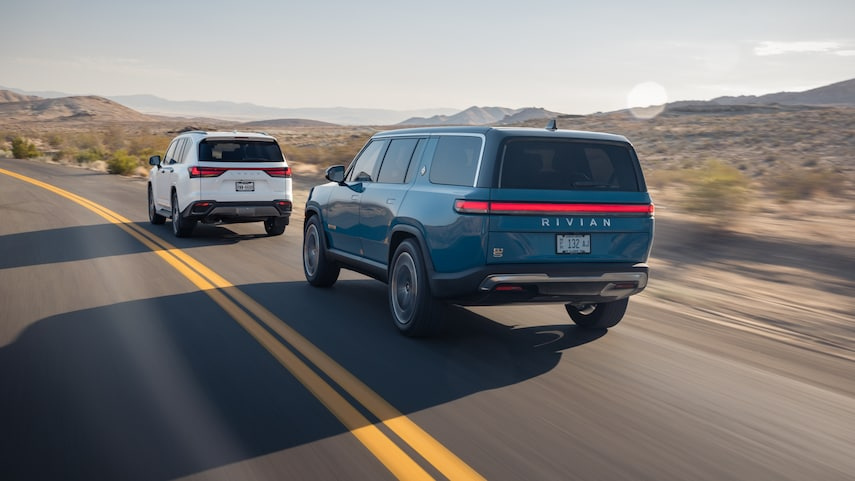
Toyota’s premium division, Lexus, is known for offering products at competitive prices compared to other luxury brands. However, at a base price of $92,165, the 2023 LX 600 is, in all honesty, quite expensive. It can go as high as $132,255.
Comparatively, the starting price of the Rivian R1S is merely $78,000. Even at about $90,000, the most expensive trim is still $2,000 cheaper than the LX 600. For consumers who can purchase one of these vehicles, the question then becomes whether the R1S is more affordable since it provides fewer features or whether the LX 600 is expensive.
Conclusion
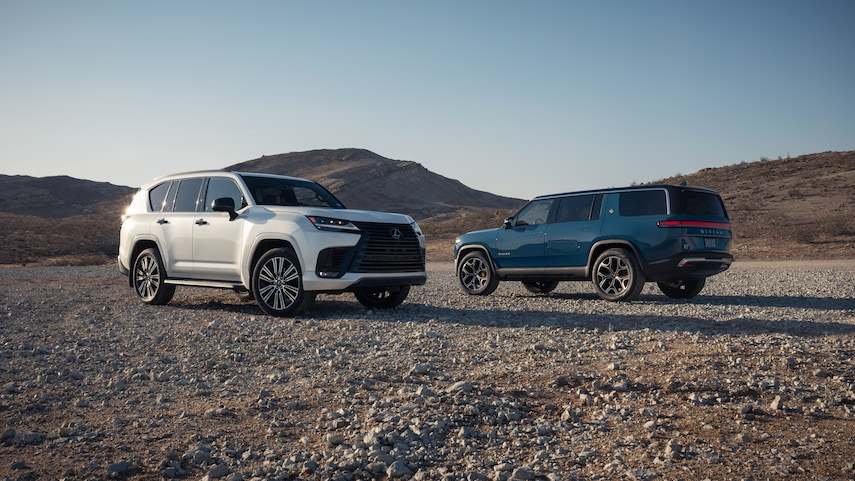
No doubt, the Lexus LX600 does well on the Land Cruiser’s capability, comfort, and Lexus’ durability and resale value, but it falls short in some areas. It’s just as capable as the model it replaces and slightly nicer to drive on paved roads, but other options offer stronger off-road performance, a smoother ride, and a more polished interior.
Comparatively, the Rivian has all the off-road tools you’ll never use. It travels the road with the elegance and refinement of a genuine luxury SUV, and it can easily gobble up miles on the highway or carve up your favorite country road.
Both the luxury SUVs have their specific features and drawbacks, which we have discussed in detail above. However, in the end, it comes down to your personal needs and preferences. In this article, we have compared the specs of both vehicles so you can make a better and more informed decision. We hope this will help you choose the vehicle that best fits your needs.




